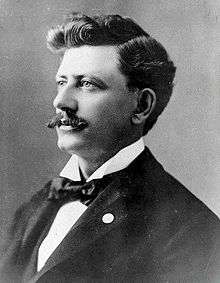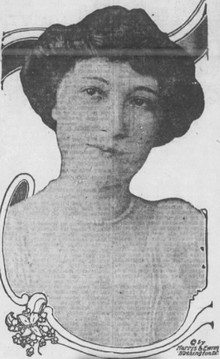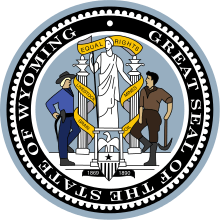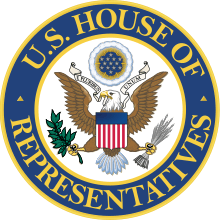John Eugene Osborne
John Eugene Osborne (June 19, 1858 – April 24, 1943) was an American physician, farmer, banker, and politician who served as the 3rd Governor of Wyoming and United States Representative as a member of the Democratic Party.
John Eugene Osborne | |
|---|---|
 | |
| 29th United States Assistant Secretary of State | |
| In office April 21, 1913 – December 14, 1916 | |
| Preceded by | Huntington Wilson |
| Succeeded by | William Phillips |
| Member of the U.S. House of Representatives from Wyoming's at-large district | |
| In office March 4, 1897 – March 3, 1899 | |
| Preceded by | Frank W. Mondell |
| Succeeded by | Frank W. Mondell |
| 3rd Governor of Wyoming | |
| In office January 2, 1893 – January 7, 1895 | |
| Preceded by | Amos W. Barber |
| Succeeded by | William A. Richards |
| Personal details | |
| Born | June 19, 1858 Westport, New York, U.S. |
| Died | April 24, 1943 (aged 84) Rawlins, Wyoming, U.S. |
| Resting place | Cedar Hill Cemetery, Princeton, Kentucky, U.S. |
| Political party | Democratic |
| Spouse(s) | Selina Smith |
| Children | Jean Curtis Osborne |
| Mother | Mary E. Rail. |
| Father | John C. Osborne |
| Education | University of Vermont College of Medicine |
Early life
John Eugene Osborne was born on June 19, 1858, although his passport stated that he was born on June 19, 1860, in Westport, New York to John C. Osborne and Mary E. Rail.[1] In 1874 Osborne moved to Burlington, Vermont where he worked at a drug store and studied medicine at the University of Vermont College of Medicine where he graduated in 1880.[2][3] Later that year he moved to Rawlins, Wyoming where he established a drug store. In 1881 he was hired as an assistant surgeon by the Union Pacific Railroad.
Big Nose George Parrott
Following the botched hanging and subsequent execution of George Parrott, also known as Big Nose George, in 1881,
His remains then embarked on a strange journey, with part of his skin being made into boots by John Eugene Osborne, the doctor who examined him after his death. Osborne wore the boots to his inaugural ball when he became governor in 1892. Osborne also gave part of George's skull to medical assistant Lillian Heath, who used the skull as a doorstop for many years.
— By Christina Schmidt, "Famous James brother made camp in Big Horn", Sheridan Press[4]
Lillian Heath was 16 when she received the skull cap of Big Nose George, and went on to become the first female physician in Wyoming.[5]
Career
Early politics
In 1883, Osborne was elected to Wyoming's House of the Territorial Assembly, but resigned in 1885, when he left the Territory for a brief period. In 1888, he was appointed chairman of the Penitentiary Building Commission and also elected mayor of Rawlins.[6] During the 1880s, Osborne was a physician and chemist in Rawlins, and operated a farm, at one point being the largest individual sheep owner in Wyoming. After the lynching of Big Nose George Parrott, Osborne helped conduct the autopsy, and had Parrot's skin tanned and made into a pair of shoes he later allegedly wore at his inauguration as governor.
Governor and House
Osborne was an alternate delegate to the Democratic National Convention in 1892.[7] In July 1892, Osborne was given the Democratic nomination for governor at the state convention on the 37th ballot although he had removed his name from consideration before being convinced to put it back up. In the general election he defeated Edward Ivinson with 9,290 votes to 7,509 votes.
On January 2, 1893, Osborne was inaugurated, wearing the shoes he had made from Big Nose George's skin, although he had attempted to take office earlier on December 2, 1892, which was ruled as invalid and premature by the Wyoming Supreme Court on January 17. He was unable to attend Grover Cleveland's presidential inauguration as he was afraid that Secretary of State Amos W. Barber would appoint a Republican during the time that he would server as acting governor in Osborne's absence. During his tenure he fought with the state legislature which was divided with 22 Republicans, 21 Democrats, and 5 Populists. He completed his term on January 7, 1895, having declined renomination.[1]
From March 4, 1897 until March 3, 1899, he served in the 55th United States Congress as the U.S. Representative from Wyoming,[8] but again declined renomination when his term expired.[9]
Later life

Osborne was a free silver supporters and during the 1896, 1900, and 1908 presidential elections he supported William Jennings Bryan. In 1896 he served as chairman of the Wyoming delegation to the Democratic National Convention, in 1898 he served as vice chairman of the Democratic National Committee, was made a member of the national committee in 1900, and served as the vice chairman of the finance committee in 1908.[10][11] During the 1904 presidential election Bryan suggested that somebody like Osborne from the western United States should run for the Democratic nomination, but Osborne chose not to run.[12]
On April 28, 1903, Governor DeForest Richards died in office shortly after winning reelection in 1902 resulting in a special election. Osborne won the Democratic nomination by acclamation, but was defeated in a landslide in the special election by Bryant Butler Brooks.[13]
On November 2, 1907, he married Selina Smith of Princeton, Kentucky after they met on the island of Madeira when Jean Curtis Smith was on a round-the-world trip with her sister and brother-in-law. According to an account in the Passenger-Inquirer of Owensboro, Kentucky, "they were engaged to be married when they landed on American soil two months later."[14] Their honeymoon was interrupted "when his efforts to secure the 1908 Democratic National Convention for the West met with success and they were obliged to hurry to [Denver," where it was to be held. Mrs. Osborne was known as the "official hostess" for the convention.[15][16]
In 1910, he served as chairman of the Wyoming Democratic Party.[17] Osborne was appointed Assistant Secretary of State by President Woodrow Wilson and served in his administration from April 21, 1913 until December 14, 1915.[18] He was also chairman of the board of the Rawlins National Bank, and engaged in stock raising.[19] In 1913, he suggested that the remains of Christopher Columbus should be placed on a battleship and travel through the Panama Canal as a part of its opening ceremony.[20] During the 1936 presidential election he was selected as one of the three Democratic presidential electors for Wyoming and vote for Franklin D. Roosevelt and John Nance Garner when the electoral college convened.[21]
Osborne was a Freemason and a member of the York Rite. On March 2, 1942, his wife died in Louisville, Kentucky. On April 24, 1943, Osborne died in Rawlins, Wyoming at age 84 after suffering a heart attack earlier in the week.[22] He was interred at the Smith family plot at Cedar Hill Cemetery in Princeton, Kentucky.
Electoral history
| Party | Candidate | Votes | % | ± | |
|---|---|---|---|---|---|
| Democratic | John Eugene Osborne | 9,290 | 53.84% | +9.22% | |
| Republican | Edward Ivinson | 7,509 | 43.52% | -11.86% | |
| Prohibition | William Brown | 421 | 2.44% | +2.44% | |
| Independent | write-ins | 36 | 0.21% | +0.21% | |
| Total votes | '17,256' | '100.00%' | |||
| Party | Candidate | Votes | % | ± | |
|---|---|---|---|---|---|
| Democratic | John Eugene Osborne | 10,310 | 49.14% | +16.97% | |
| Republican | Frank Wheeler Mondell | 10,044 | 47.87% | -4.77% | |
| People's | William Brown | 628 | 2.99% | -12.20% | |
| Total votes | '20,982' | '100.00%' | |||
| Party | Candidate | Votes | % | ± | |
|---|---|---|---|---|---|
| Republican | Bryant Butler Brooks | 14,483 | 57.48% | -0.33% | |
| Democratic | John Eugene Osborne | 12,137 | 39.27% | -0.72% | |
| Socialist | James W. Gates | 816 | 2.64% | +0.44% | |
| Prohibition | George W. Blain | 191 | 0.62% | +0.62% | |
| Total votes | '30,909' | '100.00%' | |||
References
- "John E. Osborne and the Logjammed Politics of 1893". 6 February 2016.
- "Ex-Gov. J. E. Osborne". The Burlington Free Press. 27 April 1943. p. 13. Archived from the original on 1 January 2020 – via Newspapers.com.
- "John E. Osborne". National Governors Society. Retrieved 11 December 2018.
- Schmidt, Christina (July 13, 2014). ""Famous James brother made camp in Big Horn"". The Sheridan Press.
- Van Pelt, Lori "Medicine woman: Frontier physician inspires women M.D.s", Star-Tribune, March 14, 2004. Retrieved May 9, 2018.
- "John Osborne". Wyoming State Hisyorical Society. Retrieved October 30, 2012.
- "John Eugene Osborne". The Political Graveyard. Retrieved 31 October 2012.
- "Rep. John Osborne". govtrack.us. Retrieved October 30, 2012.
- "John Eugene Osborne". Biographical Directory of the United States Congress. Retrieved 19 October 2012.
- "John E. Osborne". The Tampa Tribune. 5 July 1908. p. 8. Archived from the original on 2 January 2020 – via Newspapers.com.
- "Democratic Committees". Intelligencer Journal. 7 August 1908. p. 5. Archived from the original on 2 January 2020 – via Newspapers.com.
- "Bryan Favors Western Man". Great Falls Tribune. 2 October 1903. p. 1. Archived from the original on 2 January 2020 – via Newspapers.com.
- "John E. Osborne Chosen". The Salt Lake Tribune. 9 September 1904. p. 1. Archived from the original on 2 January 2020 – via Newspapers.com.
- Selene Armstrong Harmon, "Women Worth While," June 14, 1914, image 13 A similar account is at "On the Beach at Waikiki," Honolulu Star-Bulletin, February 11, 1932, image 2
- Marguerite Martyn, "Marguerite Martyn Finds Many Interesting Women in Denver Taking Part in the Preliminaries to the Democratic Convention," St. Louis Post-Dispatch, July 5, 1908, image 1
- "Official Hostess at Denver Is Bride of Former Governor," St. Louis Post-Dispatch, July 5, 1908, image 1
- "Roosevelt And Garner Given Party Support". Casper Star-Tribune. 23 April 1943. p. 10. Archived from the original on 2 January 2020 – via Newspapers.com.
- "John Eugene Osborne". US Department of State: Office of the Historian. Retrieved October 30, 2012.
- "John E.Osborne". Wyoming History. Retrieved October 30, 2012.
- "Columbus Buried In San Domingo?". Evening Star. 17 July 1913. p. 11. Archived from the original on 2 January 2020 – via Newspapers.com.
- "Roosevelt And Garner Given Party Support". Casper Star-Tribune. 12 May 1936. p. 1. Archived from the original on 2 January 2020 – via Newspapers.com.
- "Death Takes Physician, Wyoming Ex-Governor". The Salt Lake Tribune. 26 April 1943. p. 18. Archived from the original on 1 January 2020 – via Newspapers.com.
External links
- John E. Osborne (D), Wyoming state archives
- The Hanging of Dutch Charley and Big Nose George, the election of John E. Osborne, Wyoming Tales and Trails
- "An Outlaw's Skin Was Made Into Shoes — Should they be on display?", by Eric Grundhauser, Atlas Obscura, December 19, 2017. Retrieved May 9, 2018.
- National Governors Association
- Biographical Directory of the United States Congress
- John Eugene Osborne at Find a Grave
- govtrack.us
- Wyoming State Historical Society
| Party political offices | ||
|---|---|---|
| Preceded by George W. Baxter |
Democratic nominee for Governor of Wyoming 1892 |
Succeeded by William H. Holliday |
| Preceded by George T. Beck |
Democratic nominee for Governor of Wyoming 1904 |
Succeeded by Stephen A. D. Keister |
| First | Democratic nominee for U.S. Senator from Wyoming (Class 2) 1918 |
Succeeded by Robert R. Rose |
| Political offices | ||
| Preceded by Amos W. Barber |
Governor of Wyoming January 2, 1893 – January 7, 1895 |
Succeeded by William A. Richards |
| Preceded by Huntington Wilson |
United States Assistant Secretary of State April 21, 1913 – December 14, 1915 |
Succeeded by William Phillips |
| U.S. House of Representatives | ||
| Preceded by Franklin Wheeler Mondell |
Member of the U.S. House of Representatives from Wyoming's 1st congressional district March 4, 1897 – March 3, 1899 |
Succeeded by Franklin Wheeler Mondell |

